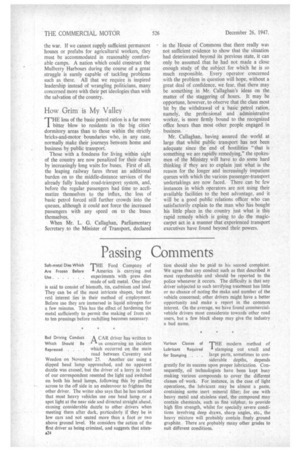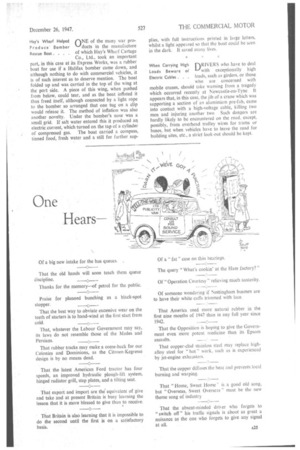Passing Comments
Page 26

Page 27

If you've noticed an error in this article please click here to report it so we can fix it.
Soft-metal Dies Which THE Ford Company of Are Frozen Before America is carrying out Use experiments with press dies made of soft metal. One alloy is said to consist of bismuth, tin, cadmium and lead. They can be of the most intricate shapes, but the real interest lies in their method of employment. Before use they are immersed in liquid nitrogen for a few minutes. This has the effect of hardening the metal sufficiently to permit the making of from six to ten pressings before redlining becomes necessary.
Bad Driving Conduct A. CAR driver has written to Which Should Be r-k us concerning an incident Repressed . . which occurred on the main road between Coventry and Weedon on November 25. Another car using a dipped head lamp approached, and no apparent dazzle was caused, but the driver of a lorry in front of our correspondent resented the light and switched on both his head lamps, following this by pulling across to the off side in an endeavour to frighten the other driver. The writer also says that he has noticed that most heavy vehicles use one head lamp or a spot light at the near side and directed straight ahead, causing considerable dazzle to other drivers when meeting them after dark, particularly if they be in low cars and not seated more than a foot or two above ground level. He considers the action of the first driver as being criminal, and suggests that atten£24 tion should also be paid to his second complaint. We agree that any conduct such as that described is most reprehensible and should be reported to the police whenever it occurs. The difficulty is that any driver subjected to such terrifying treatment has little or no chance of noting the make and number of the vehicle concerned; other drivers might have a better opportunity and make a report in the common interest. On the average, we have found commercialvehicle drivers most considerate towards other road users, but a few black sheep may give the industry a bad name.
Various Classes of THE modern method of Lubricant Required I stamping out small and for Stamping . . large parts, sometimes to con siderable depths, depends greatly for its success upon proper lubrication. Consequently, oil technologists have been kept busy making various compounds to cover the different classes of work. For instance, in the case of light operations, the lubricant may be almost a paste, containing some inert mineral filler; for use with heavy metal and stainless steel, the compound may contain chemicals, such as fine sulphur, to provide high film strength, whilst for specially severe conditions involving deep draws, sharp angles, etc., the heavy mixture will probably contain . finely ground graphite. There are probably many other grades to suit different conditions. 0NE of the many war products in the manufacture of which Hay's Wharf Cartage Co., Ltd., took an important part, in this case at its Express Works, was a rubber boat for use if a Halifax bomber came down, and although nothing to do with commercial vehicles, it is of such interest as to deserve mention. The boat folded up and was carried in the top of the wing at the port side. A piece of this wing, when pushed from below, could tear, and as the boat inflated it thus freed itself, although connected by a light rope to the bomber so arranged that one tug on a clip would release it. The method of inflation was also another novelty. Under the bomber's nose was a small grid. If salt water entered this it produced an electriccurrent, which turned on the tap of a cylinder of compressed gas. The boat carried a compass, tinned food, fresh water and a still for further sup
Hay's Wharf Helped Produce" Bomber Rescue Boat . . .
plies, with full instructions printed in large letters, whilst a light appeared so that the boat could be seen in the dark. It saved many lives.
When Carrying High nRIVERS who have to deal Loads Beware of "with exceptionally high Electric Cables . . , loads, such as girders, or those who are concerned with mobile cranes, should take warning from a tragedy which occurred recently at Newcastle-on-Tyne. It appears that, in this case, the jib of a crane which was supporting a section of an aluminium pre-fab, came into contact with a high-voltage cable, killing two men and injuring another two. Such dangers are hardly likely to be encountered on the road, except, possibly, from overhead trolley wires for trams or buses, but when vehicles have to leave the road for building sites, etc., a strict look-out should be kept.












































































